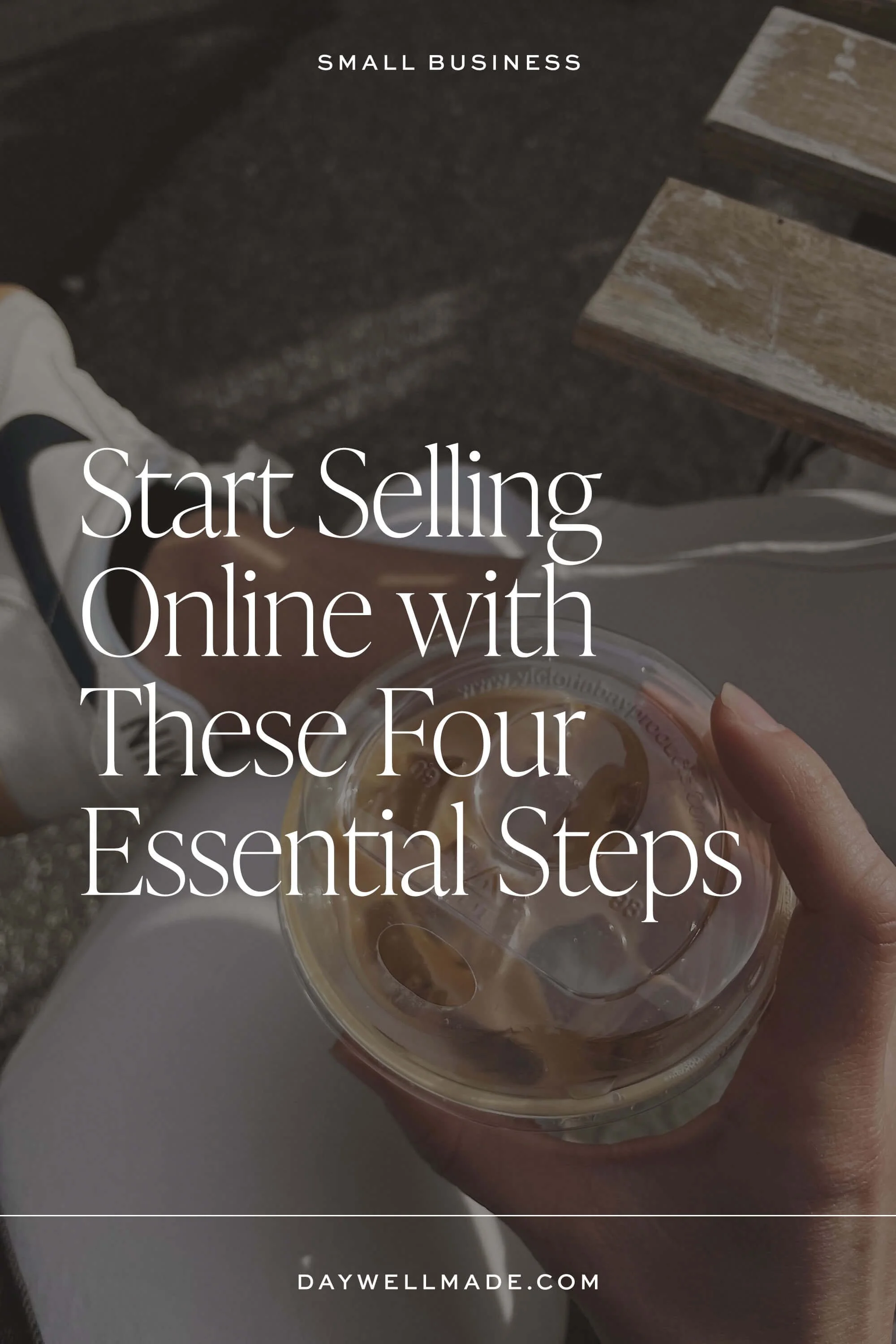Start Selling Online with These 4 Essential Steps
You finally stumbled on a business idea you’re excited about that holds serious potential, and now you can’t WAIT to get started — congrats!!!
Thinking of a viable idea that you’re genuinely excited about is often one of the biggest roadblocks to getting started when creating your own business.
Next, you might be thinking of how to make this business a reality.
Creating and finessing the product itself, sourcing materials or structuring service packages, getting the word out, etc. are all going to be important steps as you enter the beginning stages of your business.
But alongside the product or service itself (your “offering”), have you thought about HOW you’re going to logistically manage the necessary online experience for selling your creation?
It’s not as intimidating as you might think!
I’m sharing the four basic essentials of online selling below that you need to know so you can start planning how your business operates from the back end.
01. A way to list your offering
This first one is probably one you’ve already been thinking about:
How and where will you list your offering available for sale?
Many online businesses use a dedicated website that’s solely set up for the functionality of your business, including product listings, a little about your company, FAQs, a way to get in touch, etc.
And honestly, websites these days are not nearly as intimidating as they used to be! You can be up and running in an hour with easy-to-use platforms like SquareSpace, Shopify, Wix, Weebly, and others.
(Sites like Wordpress, Showit, and Webflow are AMAZING options, as well — but sometimes have a bit more of a learning curve, depending on your comfort level with web design and setup.)
But is that the only option?
Actually, no!
With a background in web design, having a dedicated website — no matter how simple — is my personal preference for hosting your product suite, as it can establish credibility, trustworthiness, and a more controlled user experience.
HOWEVER, there are additional options that might make sense when first starting out.
Online marketplace
Today, there are online marketplaces for just about any product or service you’re thinking of offering. Etsy is one of the most well-known, featuring handmade products, vintage items, and more (this is actually where I started selling products!). Even Amazon falls into this category. But there are others for almost anything you can imagine.
The beauty of using an online marketplace is convenience — easy setup, access to an expansive network of shoppers, and a done-for-you payment processing system. It’s all built in to the platform, generally, making the process of listing, selling, and fulfilling an easier way to learn.
The cons of using an online marketplace can be heavy saturation in your space, as well as hefty fees taken out by the marketplace of your choice. But when it comes to convenience, using an existing online marketplace might be the way to get started with selling.
An idea to think about here: you can actually set up a basic website, but LINK your products to an online marketplace, taking advantage of benefits from both solutions.
Social Media
The best thing about social media? It’s FREE. And many platforms offer “business” account types that give you access to special tools and analytics to help your business thrive.
You can go about listing your items on social media in one of two ways — by connecting your account to your website and verifying the credibility of your shop (this option includes a seamless purchasing experience for your customers on platforms like Facebook and Instagram).
OR, you can honestly just list products and prices directly on the platform for a more manual experience. In this instance, you might directing customers to DMs for claiming and paying for your offering, or even just having them comment “SOLD” in the comments of your photo listing.
I’ve seen many businesses get started this way and had success doing so!
Legal note: I do recommend doing a little research on the legality of selling your specific products on social media — and honestly, this goes for anything you sell online anywhere! Be mindful of potential issues like copyright infringement before taking off running with your idea.
02. A way to sell your offering
You’ve determined where you want to list your offerings… but how will you logistically SELL them?
There may be good news in store here:
If you choose a platform for listing your offerings that includes a full e-commerce experience, you may already have the answer to this one — your listing platform could also be where you process transactions!
For instance, if you’re listing your offerings on an online marketplace, the transaction part of the process is already built in. Done!
If you’re listing on your website, many websites have e-commerce capabilities with this option already built in — but you also have the choice to redirect customers to a marketplace or other method for transaction process. For example, listing your products and info on your own website, but when a customer clicks on a product to “buy,” the button could redirect to the product listing in your chosen marketplace to complete the sale.
Keeping the entire process as seamless and cohesive as possible is always the best route (such as housing the entire process on your own website), but just know there are alternative solutions for payment processing you can explore, as well.
If you’re selling your product or service manually through social media — without the use of their built-in shopping and transaction options — you will want to think of the best method for collecting payment and information from your customers that’s secure, easy, and legal.
Pro Tip: Simply requesting a “friends and family payment” via a processor like PayPal in order to avoid fees isn’t a legal option, unfortunately. Processing fees through any platform are considered a part of business expenses and should be thought of ahead of time when setting your prices for various offerings. These fees are already a part of the payment and billing structure when using transaction processing via your website or online marketplace. You should be able to find details of various fees for your platform based on the plan you choose upon setup — or you can always reach out their customer service team for clarification.
Looking for platforms and tools to keep your start-up costs low? Click here for five of my favorite FREE resources for starting a business that will absolutely come in handy on your journey to building this new venture.
03. A way to fulfill your offering
Once offerings are listed and sales are made (yay!), it’s time to fulfill your offering to your customer.
If this is a digital product, there are many platforms, such as Shopify, SquareSpace, and online marketplaces, that have the ability to automatically fulfill the product — so no extra steps needed on your end.
If this is a service offering, there are also platforms you can use to automate parts of this process — or even the entire thing! Websites like Dubsado, Honeybook, and 17Hats all have functionality to ease the fulfillment and communication process for service offerings, saving you time and helping to ensure credibility and reassurance on your client’s end.
If this is a physical product, fulfillment can look vastly different from business to business. Many websites and online marketplaces have fulfillment systems built in — or featured as add-ons — that’ll ease this process by keeping track of sales, customer info, ship status, tracking info, etc.
For instance, my physical product business most recently operated through Shopify; Shopify handled the entire transaction from start to finish as one seamless experience, including updating my customers via email as soon as their order shipped with included tracking info! All I had to do was package the item, print the shipping label, and send it on its way.
No matter which option you choose for fulfillment, your goal should be to automate this process as much as possible while maintaining a seamless, trustworthy, secure experience for your customers.
04. A way to promote your offering
Ok, so listen: while I wish “build it and they will come” was a solid business philosophy, the truth is that you need to make an active, continuous effort to MAKE YOUR BUSINESS AND PRODUCTS KNOWN.
In other words, how will you drive traffic, spread the word, and promote your offerings?
Like I mentioned above, online marketplaces have built-in audiences, this is true. But with high saturation in many of these spaces, these online marketplaces alone are not a dependable source alone for ongoing traffic and sales.
It’s up to you to make that happen.
The good news is that there are SO many ways to ethically promote your offerings if you’re willing to get a little creative — many of which are free and just need a little time invested.
Here’s a list of some of my favorites for promoting your goods and services, no matter what you sell:
Social media (this one is a category all on its own due to the number of ways you can promote via social, soooo look out for a future post on how to do just that)
Word of mouth
Online groups + communities
Local groups + communities
Referral + affiliate programs
Email marketing
Guest blogging
Podcast, blog, + YouTube interviews
Guest expert in existing groups, memberships, + communities
SEO
Email signature
HARO
Incorporate your strategy into an amazing customer service experience
…and truthfully, this is just scratching the surface when it comes to promotional ideas for your business! My biggest piece of advice when first starting out is to leverage your strengths by trying promotional ideas that feel exciting and intuitive for you. If being interviewed on a podcast sounds terrifying, maybe start with SEO and guest blogging, for instance.
Pro Tip: One of the BEST things you can do for your business from day one is to start building an email list. Create a simple form for customers to opt into on your website (you cannot legally just add names and emails to your list without permission, so let’s keep it ethical), and slowly start building that list as soon as possible. This will be your most loyal base of customers and clients — not to mention, you own this list through your business… whereas social media accounts get hacked every single day and cause so much distress for business owners. Email marketing is the one promotional strategy I highly encourage you to use above all else! I included a few free email marketing platforms in this post.
With a plan to list, sell, fulfill, and promote your offerings, you’re WELL on your way to building a credible, ethical, and successful business, no matter what you sell!
Wait, you’ll love this —
The Day Well Made Digest is your Thursday coffee date with a friend (that’s me!) who happens to know a lot about marketing, has great taste in design, and always has the best book recommendations . . . delivered straight to your inbox.





